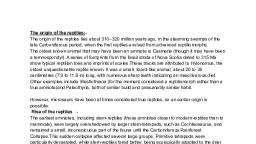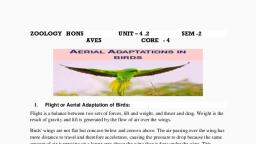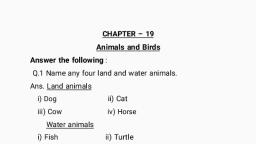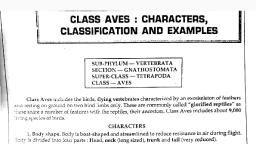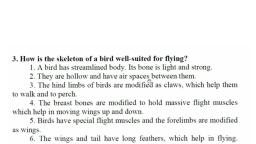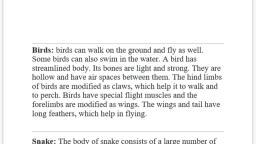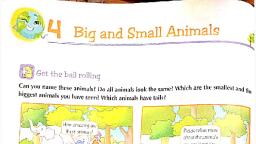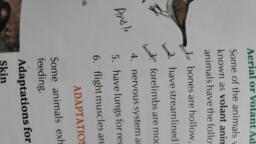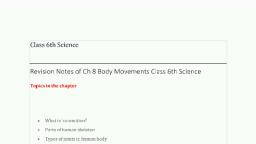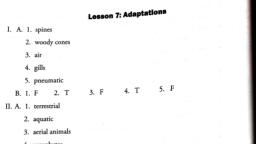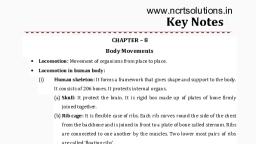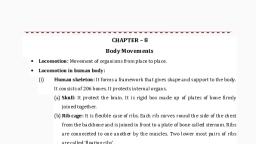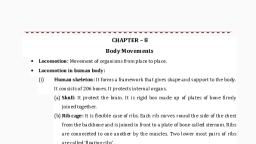Page 1 :
Flight adaptations in, birds, B. Sc. Part I, Paper II, By- Dr. Vandana Kumari, Department of Zoology, R.C.S. College Manjhaul
Page 2 :
Introduction, • Birds constitute a well defined group of vertebrate animals, especially, designed and adapted for aerial mode of life. They evolved not only wings,, but many other adaptations that make it possible to fly. Feathers makes the, body light and provide insulation. Hollow bones reduces the body weight., Replacement of jawbones and teeth with beak, and many more features. All, these changes can be studied under morphological, anatomical and, physiological changes responsible for flight adaptations.
Page 3 :
Morphological adaptations, •, •, •, •, •, •, , Body contour or shape, Compact body, Body covering of feathers, Forelimbs modified into wings, Short tail, , Beak, , •, •, •, •, , Mobile neck and head, Bipedal locomotion, Integument, Large muscles of flight or flight, muscles, , • Perching
Page 4 :
Morphological adaptations, • BODY SHAPE, , • Birds have short, light and compact body as compared to other animals., • Most organs and large muscles are located near the center of gravity, which is, slightly below and behind the wings to provide better balance during flight., , • Compact body, • The body is compact and light, strong dorsally and heavier ventrally. Attachment, of wings high on the thorax. the light organs like lungs and sacs are positioned, high, the heavy muscles placed centrally are other features that help in flight.
Page 5 :
Flight adaptation
Page 6 :
Feathers, • Body Covered With Feathers, • The feathers are smooth, directed backwards, and closely fitting which make, the body streamlined and reduce friction during flight. It lightens the body, weight and protects it from the effect of environmental temperature. They, also have a wide surface area for striking the air., , • Feathers add to the body buoyancy. It insulates the body and prevents any, , loss of heat from the body. This helps the birds to bear low temperatures at, higher altitudes.
Page 7 :
Adaptation in feathers
Page 8 :
Wings, • Forelimbs Modified into Wings, • The forelimbs are modified into wings which is the only organ of flight. These, consist of a framework of bones, muscles, nerves, feathers, and blood vessels., , • The wings have a large surface area. They also support the bird in the air. The wings, have a thick strong leading edge with a concave lower surface and a convex upper, surface. This helps in increasing the air pressure below and reducing the air pressure, above. Thus the bird can fly upward and forward during flight.
Page 9 :
•, , Perching, , •, , When a bird sits on the branch of a tree, its toes wrap around the twig. This is known as perching. The muscles are so well-developed that a bird can sleep in that, position without falling., , •, , Short Tail, , •, , The tail bears long feathers that spread like a fan and function as a rudder during flight. They also help in balancing, lifting, and steering while flying and perching., , •, , Beak, , •, , Beak compensate the function of forelimbs., , •, , Mobile Neck and Head, , •, , The birds have a long and flexible neck which helps in the movement of head important for various functions. They possess a horny beak which helps them to pick the, grains and insects while feeding., , •, , Bipedal Locomotion, , •, , The anterior part of the body of a bird helps in taking off during flight. The anterior part of the body also helps birds to land. The hindlimbs help in the locomotion on, land. They can support the entire body weight of a bird
Page 10 :
• Mobile neck and head, • Neck of bird is very long and flexible provide mobility of the neck and freedom of, movement of the head., , • Bipedal locomotion, • Due to the modification of forelimb into wings, hind balance and support the entire, weight of the body., , • Integument, • Loose skin is responsible for the extensive movement of the skeletal musculature.
Page 11 :
Anatomical adaptation, • Endoskeleton, •, •, •, •, •, •, •, •, , Many adaptations are seen in the skeleton of birds., Most of the bones are pneumatic and filled with air sacs instead of bone marrow., Skull bones are light and most of them fused together., Uncinate processes of thoracic rib help in producing compactness., A firm fulcrum for the action of wings., Shortening of caudal style and formation of pygostyle for stability in the air., Fusion of pelvis with synsacrum provide firm attachment to the legs., , Sternum greatly expanded, provided with mid –ventral ridge or keel in flying birds.
Page 13 :
Skull, • Skull is composed of thin, hollow, bones, which is extremely light in, proportion to the rest of the body, due to elimination of a heavy jaw,, jaw muscles, and teeth. The job of, chewing has largely replaced by, the gizzard. The skull usually, represents less than 1 percent of, a bird’s total body weight.
Page 14 :
Flight muscles, • Flight muscles are enormous as, , they have to generate thrust and, vigorous movement of wings, during flight., , • Flight muscles on the breast are, greatly developed., , • Pectoralis major lowers the wings., • Pectoralis minor elevates the wings.
Page 15 :
Physiological adaptations, • Circulatory System, • Rapid supply of oxygen is required by the blood due to high metabolic rate in birds. Therefore, birds require an efficient, , circulatory system. Birds have a four-chambered heart that performs double circulation. This prevents the mixing of, oxygenated and deoxygenated blood. Also, the birds contain a large amount of haemoglobin in their red blood cells which, helps in the quick aeration of body tissues., , • Warm Blooded, • Birds are worm blooded animals. The temperature of the body of a bird remains high and does not change with the change, in the environment. Perfect aeration of body provide maximum output of energy for a longer period This facilitates the, birds to fly at very high altitudes., , • Excretory System, • The nitrogenous waste is converted to less toxic organic compounds such as uric acid, and urates. They have no urinary, bladder. The uriniferous tubules efficiently absorb water.
Page 16 :
Circulatory system
Page 17 :
Digestive system, • Digestive system is compact and, effective., , • The birds have a very high rate of, , metabolism. Therefore, food, digests rapidly. The length of the, rectum is reduced because of the, minimum undigested waste. They, have no gall bladder which reduces, the weight of the bird.
Page 18 :
Respiratory System, • The respiratory system of birds is, , designed in such a manner that the, food is oxidised rapidly and a large, amount of energy is liberated. Since, the metabolism rate is higher, a large, number of oxygen molecules are, required by the body. For this, the, lungs are provided with unique system, of air sacs which occupy the entire, space between the internal organs.
Page 19 :
Reproductive system, • Ovaries and testes are reduced in size except in the breeding season. Usually, , only one functional ovary is present in most of the birds and second ovary is, greatly reduced to decrease the weight of body. Female liver is displaced to, the right to compensate for weight difference. But in the case of birds of, prey generally both ovaries and oviducts are present. This is because during, hunting these birds have to pounce on the prey with great force and, struggling prey can kick and break the eggs in reproductive system. Eggs, developing in two ovaries can compensate for this loss.
Page 21 :
Conclusion, The evolution of flight has provided birds with many physical features in addition to wings and feathers. One way to reduce, weight in birds is by the fusion and elimination of some unnecessary bones and the “pneumatization” of the remaining ones., Not only are some bones of birds hollow but many of the larger ones are connected to the air sacs of the respiratory system., To keep the cylindrical walls of a bird’s major wing bones from sudden change the bones have internal compressive framework., Fusion of bones in birds makes the skeleton light as well as strong. Coracoid, furcula, and scapula form a strong and well built, tripod for supporting the wings and broad surfaces for the attachment of large flight muscles., One key adaptation is the fusing of caudal bones into single pygostyle which supports the tail feathers. Birds also lack teeth or, even a true jaw, instead having evolved a beak, which is more lightweight., Birds have uncinate processes on the ribs. These are hooked extensions of bone which help to strengthen the rib cage by, overlapping with the rib behind them., There is practically every organ and system has been modified in relation to flight.
